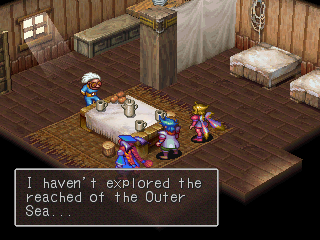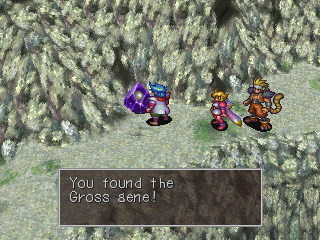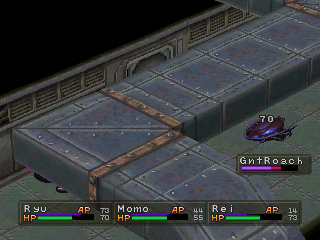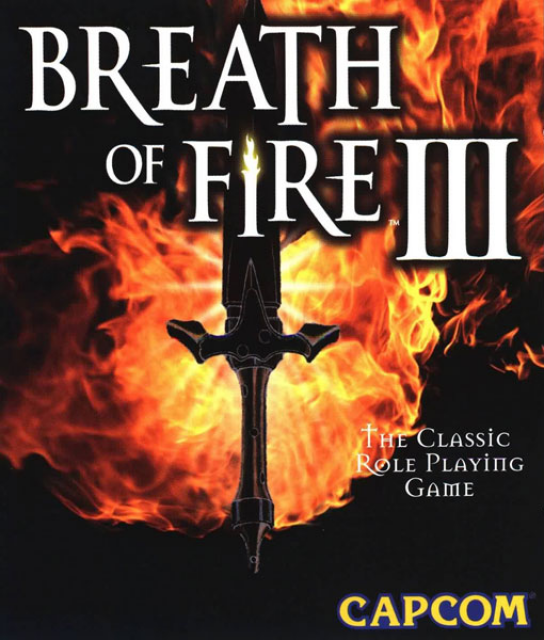So many good ideas, but the execution essentially ignores them.
If Sony’s first console were known for two things, those things would be JRPGs and trying new things. Obviously, Breath of Fire III serves as a great example of both these attributes in action. However, many of the ideas it tries to implement either are of little consequence or flawed in some way, shape, or form.
Breath of Fire III starts with the protagonist caught in a magic crystal, confused, not sure of what is going on or where to go. Soon, however, he unites with two young thieves and the group proceeds to cause harmless mischief to the nearby town. This is where the story starts to unravel slowly, as the cast rarely has a permanent goal in mind. In fact, one goal (and a few characters) is entirely forgotten along the way, only to come up near the end, as if to tie up loose ends quickly before the end of the game. Along with the goals, the main villains also change, even though the game lacks any true villain. The two characters that come close to any type of villain are more bumbling pawns of a higher power than serious threats, and the ultimate villain is ambiguous and prefers to do things behind the scenes. Although the story picks up halfway through, and it tries to use the lack of a villain to its advantage (to mild success), this does not compensate for what it does to the rest of the story: leave the characters without any kind of permanent objective or reason to fight.
Oddly enough, despite not having a single goal, all the characters are well developed.

This ability carries over to battle as well, although to a slightly lesser extent. Breath of Fire III uses a classical turn based battle system with very little fringes, the fringes changing absolutely nothing. Characters can learn magic/abilities either through leveling up, learning them through enemies, or by apprenticing themselves under a master. With the latter system, you level up a certain amount of levels, and then return to the master so that they can teach you a new ability. However, since you are always moving about the surprisingly small world map, rarely will you have the time to go to that one isolated area the master resides in, not even by the end of the game. (While there is more freedom by the end of the game, there are still limitations that keep you from going anywhere at certain times.) Besides, many of these abilities are either obtainable through other methods, completely useless, or both. This remains true of the enemy ability system, the only difference being that they are somewhat easier to acquire.

Yet minor issues and barely executed ideas ruin the battle system itself, while perfectly fine on its own. For example, if a character levels up, any extra EXP does not carry over from the level up. When combined with the fact that characters only gain EXP when they battle (unlike other RPGs, where characters level up, regardless of whether or not they battled) and the fact that you cannot always choose who is in your party, and this becomes annoying quickly. In addition, if a character dies in battle and is not revived by the end, they come back with a lower maximum HP, for some reason. The only way to restore their previous status is to stay at an inn. The idea was not good to begin with, and it seems like a poor excuse to get the player to waste their money on an inn.
Other than that, there are not many reasons to stay at an inn; camping outside is free, gives you more options, and rarely does the game keep you away from the overworld map. Even outside of battle, the theme of “good ideas, invisible execution” can be seen. Aside from the inns, another reason to go to town (in theory) is the inoculation system. You can buy certain inoculations that protect you from things like elemental attacks or status effects, but they wear off once you stay at an inn or camp out. Like learning moves from enemies, there is really no benefit or incentive to using these and not using them does not add a significant level of challenge to the game.
This theme even carries over to minor areas, like the overworld. Although there are no random encounters, the game tempts you into situations where random encounters can happen by scattering treasure spots all over the world map. Each spot is a small field where you can obtain a certain item, the only price being that monsters can attack you. It works well very early in the game, when you, the items, and the enemies are all very basic and low leveled. However, the enemies and items in these areas stay at the same level throughout the entire game, removing any incentive to collect them once you are a few hours into the game.
The only idea that Breath of Fire III seems to pull off without any major flaws is the Fairy Village sidequest, which allows you to manage a fairy village and how it functions. It can be hard for those who do not know what they are doing, but those who do will find a fun distraction from the main quest.

Yet other ideas seem to be poorly executed rather than completely ignored. For example, the environments and spells are rendered in 3D, while everything else is represented through 2D sprites. You see everything from a fixed isometric perspective, and the same environments are used for dungeons and battle. While this may sound good in theory, the fixed camera angle often obstructs your view, and the slight transparency between turns does not help.
In addition, the 3D graphics look incredibly flat; many objects quite clearly look like textures mapped to polygon faces rather than the 3D items they try to resemble. Even some of the spells can look very wireframe-esque at times. Breath of Fire III’s true strength lies in 2D; each sprite is very detailed and pleasing to look at, especially with larger sprites (bosses, dragons, etc.). Unlike the 3D graphics, the 2D graphics in Breath of Fire III have aged fairly well.
However, the music has not aged as well. That is not to say that the music is bad, just that it shows its age. The semi-orchestral instrument choice and the general beat of each song are the largest indicator that this is a Playstation game. However, many of the tracks are highly enjoyable, like the overworld and battle themes. The only truly bad parts to the Breath of Fire III soundtrack are the lack of the triumphant Breath of Fire theme and the awful J-pop end theme. Other than that, the soundtrack does not have any major blemishes.
Given that many RPGs were released for the Playstation, it should come as no surprise that many of them tried something to stand out from other games of the time. Understandably, many RPGs were also left in the dust in favor of better games. Breath of Fire III somehow manages to fulfill both these traits. While it tries to do a lot that many games have not done, very little of it seems to make an impact. However, if you look past all the ideas that failed to be utilized, you will find a competent JRPG with a decent story and detailed 2D graphics.
